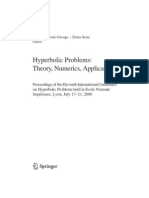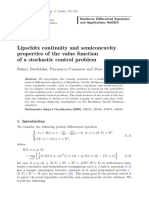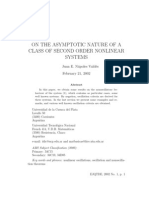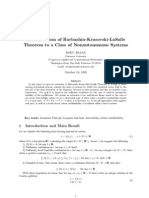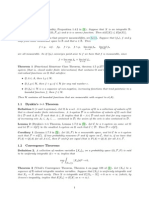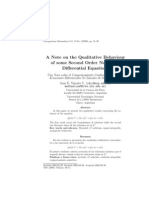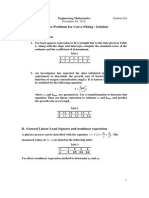Convergence in Nonlinear Systems With A Forcing Term: 1 Preliminars
Convergence in Nonlinear Systems With A Forcing Term: 1 Preliminars
Uploaded by
profjnapolesCopyright:
Available Formats
Convergence in Nonlinear Systems With A Forcing Term: 1 Preliminars
Convergence in Nonlinear Systems With A Forcing Term: 1 Preliminars
Uploaded by
profjnapolesOriginal Title
Copyright
Available Formats
Share this document
Did you find this document useful?
Is this content inappropriate?
Copyright:
Available Formats
Convergence in Nonlinear Systems With A Forcing Term: 1 Preliminars
Convergence in Nonlinear Systems With A Forcing Term: 1 Preliminars
Uploaded by
profjnapolesCopyright:
Available Formats
Revista de Matematica: Teor y Aplicaciones 4(1): 14 (1997) a
convergence in nonlinear systems with a forcing term
J. E. Napoles1 A. I. Ruiz2
Abstract The problem of convergence, as t +, of solutions of the system (1) is considered. It is assumed that the functions , f and g are of class C 1 for all values of their arguments, furthermore g (x) > 0, f (x) r > 0, 0 < n (y) N < + and the functions a(t) and p(t) are continuous on [0, +) with 0 < a a(t) A < + and p(t) 0. Resumen Se considera el problema de la convergencia, cuando t +, de las soluciones del sistema (1). Se asume que las funciones , f y g son de clase C 1 para todos los valores de sus argumentos y que adems g (x) > 0, f (x) r > 0, 0 < n (y) N < + a y las funciones a(t) y p(t) son continuas sobre [0, +) con 0 < a a(t) A < + y p(t) 0.
Preliminars
x y = (y) f (x), = p(t) a(t)g(x), (1)
We consider the system:
where the functions involved are of class C 1 for all values of their arguments, we also assume that g (x) > 0, f (x) r > 0, for all x R and 0 < n (y) N < +, for all y R and the functions a(t) and p(t) are continuous functions on [0, +) with 0 < a a(t) A < + and p(t) 0. In this paper we study the problem of convergence, when t +, of all solutions of the system (1). If the functions involved in this system are such that (y) = y and a(t) 1, the system reduces to the well known Linards equation with forcing term: e x + f (x)x + g(x) = p(t). (2)
The purpose of this note is to generalize, to the system (1), the results of [2] concerning to the convergence of all solutions of (2) to a bounded solution, under the earlier conditions.
Department of Mathematics and Computation, ISP Jos de la Luz y Caballero, Holgu e n 81000, Cuba 2 Department of Mathematics, Universidad de Oriente, Santiago de Cuba 5, CP 90500, Cuba
1
j. e. napoles a. i. ruiz
Results
Let ((t), (t)) be a bounded solution of (1). If we set v(t) = x(t)(t), w(t) = y(t)(t) we obtain the system: v w = (w + ) () [f (v + ) f ()] , = a(t) [g(v + ) g()] . (3)
In the half plane v > 0 we consider lines w + kv = const., where k 0 for nw > av and k < 0 for nw av. We nd conditions under which trajectories of (3) intersect these lines at points where w = lv, in the direction of the origin; this means that w + k is decreasing on the solutions of system (3), i.e. there exist positive numbers P and Q such that, all the solutions of (3) cannot leave the domain |v| < P , |w| < Q by crossing the boundary v = P, w = Q when t +. Dierentiating w + kv with (3) we obtain:
z u
k
z
(r)dr
u
a(t)g (s) kf (s) ds = v a(t)g (u) kf (u) + kl (z) ,
(4)
where = u u u = + v, = z z z = + w. It follows from this that the conditions for intersection in the desired direction takes the form: k< Let: H(l) = inf R(l, t, u, z)
t,u,z
a(t)g (u) := R(l, t, u, z). l (z) f (u)
(5)
we have that the inmum take place when 1 l > r, for u such that f (u) < l1 and 1 = inf z (z). Hence we have the following: Lemma 1 The function R(l, t, u, z) reaches the inmum in the absolute extremes of the function (z). Let U (l) H(l) be any piecewise smooth function satisfying U (l) 0 for 1 l > r, U (l) < 0 for 1 l r and lim Ul(r/N ) U (l) = . Consider the homogeneous dierential equation: dw + U (w/v) = 0. dv (6)
Let the integral curve of equation (6) which passes through the point v = 0, w = w0 > 0 and which lies in the right half-plane intersect the w-axis again at w1 < 0 (if there is no such intersection, take w1 = +). Theorem 1 If w1 < w0 , then (x(t), y(t)) ((t), (t)) as t +, where (x(t), y(t)) is an arbitrary solution of (1).
convergence in nonlinear systems with a forcing term
Proof. Let : (v(t), w(t)) be a trajectory of system (1) which goes through a point P of the half-plane v > 0, by (5) and the denition of the function U (l), the trajectories of the system (3) either intersect the integral curves of equation (6) in the direction of the origin or intersect the half-axis w < 0. Assuming the opposite, suppose that the trajectory lies completely inside the bounded region limited by axis w and some trajectory L1 of (6). We write the system (3) in the form: v w = (y + (1 ))w f (x + (1 ))v, = a(t)g (x + (1 ))v (7)
where 0 , , 1. x(t) = v(t) + (t) and y(t) = w(t) + (t) is a bounded solution, from this we have: f (x + (1 )) A < +, g (x + (1 )) > 0, for some positive constants A and . n if w > 0 N if w < 0 Then if v(t) v0 > 0 for all t t0 we have that w (t) av0 and w(t) , as t +. But this is a contradiction. So: Since (y) is bounded we obtain v Av + Dw where: D = w1 < w0 From this it follows that the origin is globally stable for the system (3). (8)
Examples and related remarks
0 < g (x) < + For U (l) we can take: U (l) = (a)/(nl r) (A)/(nl r) if l > a/n , if l a/n (9)
Example 1. Let:
when a(t) 1 and (y) = y, the condition (8) for the integral curves of equation (6) coincides with the convergence condition in (6). Example 2. When f (x) r, the convergence criterion for system (1) obtained in Example 1 can be improved if, in the choice of U (l), we take into account not only the greatest and least values of g (x) and f (x) but also relations among them. Apparently the rst criterion of this type was obtained in [5]. If we consider the case where an estimate: 0 < g (x) s + tf (x) < +; s, t R+ , holds. Then we have: (a)(ln r) U (l) = ((s + tr)A)(nl r) t
if l > r/n if r/n > l > s/tn if l s/tn
j. e. napoles a. i. ruiz
If we set (y) = y, a(t) 1 and = 0, we obtain: if l > r 0 (s + t)/(l r) if r > l > s/t, U (l) = t if l < s/t which coincides with the results given in [2]. Example 3. We take now: 0 < g (x) s + t thus we derive that: a/(nl r) (s + t r)A/(ln r) U (l) = 2 t /2(s s2 t2 nl) f (x) < +, t, s R+ ,
if l > r/n if r/n > l > r/n 2s r/tn if l r/n 2s r/tn
When a(t) 1, this result coincides with the one obtained in [8]. Example 4. We consider a forced oscillator with diferential equation: x + cx + g(x) = p(t), (10)
where c > 0 is a xed constant, g : R R is suciently smooth and has limit at innity, satisfying the inequality g() < g(x) < g(+), forall x R. The function p L (R) is bounded but not necessarily periodic. We remark that system (1) is the equation (10) under suitable conditions. Assume that 0 < g (x) < c2 /4, our Theorem 1 coincides with Theorem 1.2 in [1]. Remark. If we take g (x) and f (x) bounded functions, our results are consistent with those obtained in [7].
References
[1] Alonso, J.M.; Ortega R. (1995) Boundedness and global asymptotic stability of a forced oscillator, Nonlinear Anal. 25: 297309. [2] Bibikov, Y.N. (1976) Convergence in Linard equation with a forcing term, Vestnik LGU 7: 7375 e (russian). [3] Npoles, J.E. On the boundedness and global stability of solutions of a system of dierential equations a , to appear in Rev. Ciencias Matemticas, Universidad de La Habana (spanish). a [4] Npoles, J.E. On the global stability of non-autonomous systems, submited for publication. a [5] Nazarov, E.A. (1977) The coming together of the solutions of Linards equation , Dierencial nye e Uravnenija 13: 17921795 (russian). [6] Opial, Z. (1960-61) Sur un thor`me de C.E. Langenhop et G. Seifert , Ann. Polon. Math. 9: 145155. e e [7] Repilado, J.A.; J.E. Npoles. On the convergence of solutions of a bidimensional system to unique a periodic solution , submited for publication. [8] Ruiz, A. (1993) On the convergence of solutions of system x = h(y) f (x), y = g(x) + p(t) to a bounded solution , Rev. Ciencias Matemticas, Universidad de La Habana (spanish). a
You might also like
- SA Quadratic Equation. Criterion DDocument5 pagesSA Quadratic Equation. Criterion DКамиля Кокенова100% (1)
- Weather Wax Bertsimas Solutions ManualDocument20 pagesWeather Wax Bertsimas Solutions Manualchencont0% (8)
- J. Vovelle and S. Martin - Large-Time Behavior of Entropy Solutions To Scalar Conservation Laws On Bounded DomainDocument21 pagesJ. Vovelle and S. Martin - Large-Time Behavior of Entropy Solutions To Scalar Conservation Laws On Bounded Domain23213mNo ratings yet
- Impulsive Stabilization of Delay Differential Systems Via The Lyapunov-Razumikhin MethodDocument7 pagesImpulsive Stabilization of Delay Differential Systems Via The Lyapunov-Razumikhin MethodKaradiasNo ratings yet
- Equadiff Vienne 2007Document6 pagesEquadiff Vienne 2007hhedfiNo ratings yet
- Peng - Stochastic Maximum PrincipleDocument15 pagesPeng - Stochastic Maximum PrincipleGaOn KimNo ratings yet
- On Numerical Solution of The Parabolic Equation With Neumann Boundary ConditionsDocument9 pagesOn Numerical Solution of The Parabolic Equation With Neumann Boundary Conditionsmehrdad2116No ratings yet
- Stability Theory For Ordinary Differential Equations : Journal of Differential EquatioksDocument9 pagesStability Theory For Ordinary Differential Equations : Journal of Differential EquatioksChetan SharmaNo ratings yet
- 2007 A New Comparison Principle For Impulsive Differential Systems With Variable Impulsive Perturbations and Stability TheoryDocument7 pages2007 A New Comparison Principle For Impulsive Differential Systems With Variable Impulsive Perturbations and Stability TheoryAlejandro ChiuNo ratings yet
- July 1, 2009 11:54 WSPC/102-IDAQPRT 00360Document17 pagesJuly 1, 2009 11:54 WSPC/102-IDAQPRT 00360Mehdi RezaieNo ratings yet
- Enae 641Document17 pagesEnae 641bob3173No ratings yet
- Euclidean and Function Space Null-Controllability of Nonlinear Delay Systems With Restrained ControlsDocument11 pagesEuclidean and Function Space Null-Controllability of Nonlinear Delay Systems With Restrained ControlsInternational Organization of Scientific Research (IOSR)No ratings yet
- Lipschitz Continuity and SemiconcDocument14 pagesLipschitz Continuity and Semiconctakamiya980921No ratings yet
- Samuel Nápoles LugoDocument6 pagesSamuel Nápoles LugoprofjnapolesNo ratings yet
- CringanuDocument10 pagesCringanuJessica GreeneNo ratings yet
- A Note On The Asymptotic Stability in The Whole of Non-Autonomous SystemsDocument8 pagesA Note On The Asymptotic Stability in The Whole of Non-Autonomous SystemsprofjnapolesNo ratings yet
- Glimm-1965-Communications On Pure and Applied MathematicsDocument19 pagesGlimm-1965-Communications On Pure and Applied Mathematicsnickthegreek142857No ratings yet
- Numerical Approximation of The Exact Control For The String EquationDocument14 pagesNumerical Approximation of The Exact Control For The String EquationpankajshanagNo ratings yet
- Exponential Dichotomy: Zhisheng Shuai Department of Mathematical and Statistical Sciences University of AlbertaDocument7 pagesExponential Dichotomy: Zhisheng Shuai Department of Mathematical and Statistical Sciences University of AlbertaoxxidNo ratings yet
- DsDocument24 pagesDsPop RobertNo ratings yet
- Chap 7Document24 pagesChap 7AmmarNikNo ratings yet
- Consensus of Multi-Agent Systems With Additive DelaysDocument4 pagesConsensus of Multi-Agent Systems With Additive DelaysSEP-PublisherNo ratings yet
- Polynomials and Difference Equations:: AppendixDocument9 pagesPolynomials and Difference Equations:: AppendixchrischovNo ratings yet
- Nbody DissipativeDocument44 pagesNbody DissipativeFulana SchlemihlNo ratings yet
- DIFFERENTIAL SYSTEMS WITH A SMALL PARAMETER - LlivreDocument9 pagesDIFFERENTIAL SYSTEMS WITH A SMALL PARAMETER - LlivreSonia Isabel Renteria AlvaNo ratings yet
- Fon Ull 2024 NODEADocument28 pagesFon Ull 2024 NODEAWahid UllahNo ratings yet
- Linear SystemsDocument44 pagesLinear SystemsrajuvadlakondaNo ratings yet
- c15 Laplace Trans PdesDocument10 pagesc15 Laplace Trans PdesChristina HillNo ratings yet
- Apde 2016 9 1811Document20 pagesApde 2016 9 1811SakethBharadwajNo ratings yet
- 10.1515 - Ans 2007 0309Document21 pages10.1515 - Ans 2007 0309samihabelm92No ratings yet
- Nonlinear Control Theory 2006: Off-Axis Circle CriterionDocument3 pagesNonlinear Control Theory 2006: Off-Axis Circle CriterionAli DurazNo ratings yet
- Dynamics and Differential EquationsDocument30 pagesDynamics and Differential EquationsHusseinali HusseinNo ratings yet
- Carreño Guerrero-13 LocalNull Control NStokes N-1 Controls PDFDocument15 pagesCarreño Guerrero-13 LocalNull Control NStokes N-1 Controls PDFJefferson Prada MárquezNo ratings yet
- Bounded and Stable3Document7 pagesBounded and Stable3profjnapolesNo ratings yet
- Other ApplicationsDocument78 pagesOther Applications叶远虑No ratings yet
- Laplace TransformationDocument10 pagesLaplace TransformationAhasan UllaNo ratings yet
- Note de Curs-FSIDocument86 pagesNote de Curs-FSICornel BicaNo ratings yet
- Analysis2011 PDFDocument235 pagesAnalysis2011 PDFMirica Mihai AntonioNo ratings yet
- Stability of Feedback Control SystemsDocument31 pagesStability of Feedback Control Systemsjackngare99No ratings yet
- LaSalle in Variance PrincipleDocument5 pagesLaSalle in Variance PrinciplechvngNo ratings yet
- On The Asymptotic Nature of A Class of Second Order Nonlinear SystemsDocument22 pagesOn The Asymptotic Nature of A Class of Second Order Nonlinear SystemsprofjnapolesNo ratings yet
- 337 Week 0910weeklyingDocument22 pages337 Week 0910weeklyingAtoy ValdezNo ratings yet
- Duhamel's PrincipleDocument6 pagesDuhamel's PrinciplezelihahaNo ratings yet
- Feedback Linearization Continued: Consider The Control Affine SISO SystemDocument23 pagesFeedback Linearization Continued: Consider The Control Affine SISO SystemJason ChiangNo ratings yet
- Course 5 Taylor's FormulaDocument15 pagesCourse 5 Taylor's Formulaantonia tejadaNo ratings yet
- Partial Differential Equations Example Sheet 1: BooksDocument6 pagesPartial Differential Equations Example Sheet 1: BooksNasih AhmadNo ratings yet
- Prime Spacing and The Hardy-Littlewood Conjecture B: ) Log ( ) Log (Document17 pagesPrime Spacing and The Hardy-Littlewood Conjecture B: ) Log ( ) Log (idiranatbicNo ratings yet
- An Extension of Barbashin-Krasovski-Lasalle Theorem To A Class of Nonautonomous SystemsDocument12 pagesAn Extension of Barbashin-Krasovski-Lasalle Theorem To A Class of Nonautonomous SystemsalirezafakhrNo ratings yet
- m2k Opm Lapper1Document8 pagesm2k Opm Lapper1JoanzarzalNo ratings yet
- 1 Preliminaries: 1.1 Dynkin's π-λ TheoremDocument13 pages1 Preliminaries: 1.1 Dynkin's π-λ TheoremvdoblinNo ratings yet
- Math 462: HW2 Solutions: Due On July 25, 2014Document7 pagesMath 462: HW2 Solutions: Due On July 25, 2014mjtbbhrmNo ratings yet
- Remarks On The One-Phase Stefan Problem For The Heat Equation With The Flux Prescribed On The Fixed BoundaryDocument13 pagesRemarks On The One-Phase Stefan Problem For The Heat Equation With The Flux Prescribed On The Fixed BoundaryMaiman LatoNo ratings yet
- Asymptotic Instability of Nonlinear Differential EquationsDocument7 pagesAsymptotic Instability of Nonlinear Differential EquationsYelmito Milla RodriguezNo ratings yet
- Volterra Integral Equations in Banach SpaceDocument49 pagesVolterra Integral Equations in Banach SpaceSgk ManikandanNo ratings yet
- IntroductionDocument14 pagesIntroductionslo803421No ratings yet
- Gui-Qiang G. Chen - Multidimensional Conservation Laws: Overview, Problems, and PerspectiveDocument44 pagesGui-Qiang G. Chen - Multidimensional Conservation Laws: Overview, Problems, and PerspectiveQMDhidnwNo ratings yet
- Stationary Layered Solutions For A System of Allen-Cahn Type EquationsDocument28 pagesStationary Layered Solutions For A System of Allen-Cahn Type EquationsLuis Alberto FuentesNo ratings yet
- Green's Function Estimates for Lattice Schrödinger Operators and ApplicationsFrom EverandGreen's Function Estimates for Lattice Schrödinger Operators and ApplicationsNo ratings yet
- Student Solutions Manual to Accompany Economic Dynamics in Discrete Time, second editionFrom EverandStudent Solutions Manual to Accompany Economic Dynamics in Discrete Time, second editionRating: 4.5 out of 5 stars4.5/5 (2)
- Harmonic Maps and Minimal Immersions with Symmetries (AM-130), Volume 130: Methods of Ordinary Differential Equations Applied to Elliptic Variational Problems. (AM-130)From EverandHarmonic Maps and Minimal Immersions with Symmetries (AM-130), Volume 130: Methods of Ordinary Differential Equations Applied to Elliptic Variational Problems. (AM-130)No ratings yet
- The Spectral Theory of Toeplitz Operators. (AM-99), Volume 99From EverandThe Spectral Theory of Toeplitz Operators. (AM-99), Volume 99No ratings yet
- Samuel Nápoles LugoDocument6 pagesSamuel Nápoles LugoprofjnapolesNo ratings yet
- Bounded and Stable3Document7 pagesBounded and Stable3profjnapolesNo ratings yet
- 11 TME Vol9nos1and2 pp221 232Document12 pages11 TME Vol9nos1and2 pp221 232webmat2014No ratings yet
- A Note On The Asymptotic Stability in The Whole of Non-Autonomous SystemsDocument8 pagesA Note On The Asymptotic Stability in The Whole of Non-Autonomous SystemsprofjnapolesNo ratings yet
- On The Asymptotic Nature of A Class of Second Order Nonlinear SystemsDocument22 pagesOn The Asymptotic Nature of A Class of Second Order Nonlinear SystemsprofjnapolesNo ratings yet
- QB Second OrderDocument9 pagesQB Second OrderprofjnapolesNo ratings yet
- ALGEBRA 5catDocument34 pagesALGEBRA 5catSunal JiNo ratings yet
- Pixel RelationshipDocument17 pagesPixel RelationshiphemaNo ratings yet
- Practice Problems For Curve Fitting - SolutionDocument8 pagesPractice Problems For Curve Fitting - SolutionAnonymous ya6gBBwHJFNo ratings yet
- REVIEWER For 2nd Quarter Examination in Math 8 SY 2023 PDFDocument2 pagesREVIEWER For 2nd Quarter Examination in Math 8 SY 2023 PDFLawrence Andrei G. Peña0% (1)
- Chapter 12 Euler's & Taylor's RuleDocument22 pagesChapter 12 Euler's & Taylor's Rulemuhammad iqbalNo ratings yet
- AB2 - 5 Surfaces and Surface IntegralsDocument17 pagesAB2 - 5 Surfaces and Surface IntegralsnooktabletNo ratings yet
- For Registration On U Can Use Firefox or Chrome or Any Latest Internet Explorer......Document6 pagesFor Registration On U Can Use Firefox or Chrome or Any Latest Internet Explorer......Hamza Ali SoomroNo ratings yet
- Assignment 1Document4 pagesAssignment 1Christopher HarrisNo ratings yet
- Course Outline SalahuddinDocument3 pagesCourse Outline SalahuddinProf Dr Md Saifur RahmanNo ratings yet
- Homework 3Document2 pagesHomework 3tanay.s1No ratings yet
- Partial Differential Equations Assignment #1 SolutionsDocument3 pagesPartial Differential Equations Assignment #1 SolutionsabysmeNo ratings yet
- Unit 12Document38 pagesUnit 12ramonlinebooksNo ratings yet
- Tutorial 7 SolutionDocument20 pagesTutorial 7 SolutionDivyam JainNo ratings yet
- Chapter-Wise Suggestion Paper: M201 MathematicsDocument6 pagesChapter-Wise Suggestion Paper: M201 MathematicsSoumodip ChakrabortyNo ratings yet
- The de Rham Cohomology and Its ApplicationsDocument8 pagesThe de Rham Cohomology and Its Applicationsagta0101No ratings yet
- FEA NEW Lession PlanDocument4 pagesFEA NEW Lession Planbalusharma1212No ratings yet
- NDA NA 1 Mathematics 2015 PDFDocument48 pagesNDA NA 1 Mathematics 2015 PDFsuryanathNo ratings yet
- Exercises PDFDocument8 pagesExercises PDFMeer Mustafa AliNo ratings yet
- Prealgebra2e WEB YC5bGuIDocument1,146 pagesPrealgebra2e WEB YC5bGuIRobert Mauser100% (2)
- Some Connectedness Results For Affine Manifolds: P. Lobachevsky, N. Lebesgue, K. Einstein and Z. FR EchetDocument13 pagesSome Connectedness Results For Affine Manifolds: P. Lobachevsky, N. Lebesgue, K. Einstein and Z. FR EchetYong JinNo ratings yet
- Algebraic Geometry - Van Der WaerdenDocument251 pagesAlgebraic Geometry - Van Der Waerdenandrei129No ratings yet
- Class-6 MarhsDocument6 pagesClass-6 Marhsrameshdorage12No ratings yet
- Mathematics: Self-Learning Module 4 17Document12 pagesMathematics: Self-Learning Module 4 17Rhea Abegail Ramos Cejas100% (2)
- Quick MathsDocument22 pagesQuick MathsbrindaraNo ratings yet
- Complete Trigonometry Paid Ebook by Gagan Pratap SirDocument37 pagesComplete Trigonometry Paid Ebook by Gagan Pratap SirTOM100% (2)
- Chapter 7 - F2 - A - Differentiation: Sub-Topics PageDocument1 pageChapter 7 - F2 - A - Differentiation: Sub-Topics PageMuhammad Aminnur Hasmin B. HasminNo ratings yet
- Mathematical InductionDocument36 pagesMathematical InductionPATEL BHARVINo ratings yet
- Lecture 3 - Time-Domain Analysis (Zero-Input Response)Document5 pagesLecture 3 - Time-Domain Analysis (Zero-Input Response)MnshNo ratings yet


